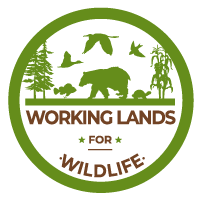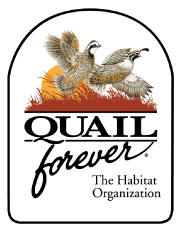Partners
Click the button on the right site to add an Organization. Include a logo plus 2-3 sentences on each major partner but don’t create new content if they are already in Landscape Partnership's Partner list. Organization must be tagged (Categorization tab) "Working Lands for Wildlife" to appear in this list.
Pennsylvania Fish and Boat Commission
The Pennsylvania Fish and Boat Commission provides fishing and boating opportunities through the protection and management of aquatic resources. The Pennsylvania Fish and Boat Commission is an independent Commonwealth agency comprised of 10 Commissioners appointed by the Governor and approved by the Legislature.
Pennsylvania Game Commission
The Commission is responsible for managing all of Pennsylvania's wild birds and mammals and enforcing the Game and Wildlife Code, Fish and Boat Code, Forestry Laws and Pennsylvania's Crimes Code. Since its formation, the Commission has purchased lands for inclusion in its State Game Lands system, which currently contains about 300 separate tracts comprising a total of more than 1.4 million acres, and dedicates an extraordinary amount of manpower to the never-ending effort of spreading the word and educating Pennsylvanians about wildlife.
Pollinator Partnership
Pollinator Partnership works with diverse stakeholders representing various perspectives with the goal of creating positive change for pollinators. We work with farmers, gardeners, land managers, scientists, and industry to develop tools and programs that help keep pollinators safe from pesticides, habitat loss, climate change, and other threats.
Project Bog Turtle
Project Bog Turtle, established in 1995, is a conservation initiative of the North Carolina Herpetological Society. Tom Thorp (Three Lakes Nature Center and Aquarium, Richmond, VA) is currently the chair and is assisted by Ann B. Somers (UNC-Greensboro, Greensboro, NC). The original project was originated in the late 1970s by Dennis Herman as a continuation of a bog turtle distribution survey, initiated by Robert T. Zappalorti (Herpetological Associates, Inc.), in southwestern North Carolina and expanded to include other southern states to locate new sites and populations of bog turtles. Most of the work, however, was conducted in North Carolina. The project involved population density studies in several sites and a captive propagation and head-start program at the Atlanta Zoological Park (now Zoo Atlanta). It was evident, as the project progressed, that additional personnel and assistance from various state, federal, and private agencies would be needed.
Purdue Extension-Forestry and Natural Resources
Purdue Extension-Forestry and Natural Resources is a part of a larger group, the Cooperative Extension Service (CES), one of the nation’s largest and best-researched providers of science-based information and education. The Purdue Extension-Forestry and Natural Resources is a great resource and reaches out not only to the state of Indiana but worldwide. We provide resources for aquaculture, fish management, urban and forestry management, natural resource planning, wildlife, and sustainable biomaterials. We encourage you to browse, download free publications, view workshops on the Purdue Extension-FNR Calendar, ask an expert, view Purdue Extension Annual Report and visit other sites that have been added as helpful links.
Quail Forever
Quail Forever is dedicated to the conservation of quail, pheasants and other wildlife through habitat improvements, public awareness, education, and land management policies and programs.
Saint Louis Zoo
The Saint Louis Zoo is dedicated to saving species and bringing people and wildlife together. Home to over 16,000 animals, many of which are endangered, entry is free every day for everyone, an important part of our commitment to people and animals – always.
South Carolina Bobwhite Initiative
The South Carolina Bobwhite Initiative is a statewide effort established in 2015 to restore bobwhite populations to early-1980s levels. Based on a plan written by the SC Department of Natural Resources and supported nationally by the NBCI (National Bobwhite Conservation Initiative), the work is directed by the SC Quail Council, a group of government and non-governmental agencies, organizations, and individual landowners. These people bring a wide range of expertise, ideas, and endless enthusiasm to our common goal and are eager to see this part of our sporting heritage return to prominence.
Southeastern Grasslands Institute
SGI seeks to integrate research, consultation, and education, along with the administration of grants, to create innovative solutions to address the multitude of complex issues facing Southeastern grasslands, the most imperiled ecosystems in eastern North America.
Southeastern Hellbender Conservation Initiative
The Southeastern Hellbender Conservation Initiative (SEHCI), a collaboration between Defenders of Wildlife, NRCS and other conservation partners to support farmers using conservation practices on their lands that help restore hellbender habitat.
Susquehannock Wildlife Society
Susquehannock Wildlife Society is a 501(c)3 non-profit dedicated to protecting our native wildlife and its habitat in and surrounding the lower Susquehanna River basin through rescue, research, education, and conservation.
Tall Timbers Research Station & Land Conservancy
Tall Timbers is recognized as the home of the study of fire ecology and is an advocate to protect the right to use prescribed fire for land management. It is also recognized as one of the nation’s leading land trusts.
Tennessee River Basin Network
Tennessee River Basin Network aims to inspire and empower people to effectively steward the region's aquatic biodiversity. The Network is comprised of two Communities of Practice (Science & Management, Communication & Outreach) to promote engagement and collective learning. By bringing members of shared expertise and experience together regularly, partners are given the opportunity to help one another and share information and resources, thus enhancing the efficiency and effectiveness of conservation efforts.
The Conservation Foundation
The support of more than 5,000 members and 500 volunteers helps us carry out our mission to improve the health of our communities by preserving and restoring open space and natural lands, protecting rivers and watersheds, and promoting stewardship of our environment in northeastern Illinois. We focus our work in DuPage, Kane, Kendall, and Will Counties where we have helped preserve more than 35,000 acres of open space, and we also go where we are needed in LaSalle, DeKalb, and Grundy Counties.
The G.A.M.E. Lab
The Gamebird And Managed Ecosystems Lab is a research program at the University of Georgia within the Warnell School and Savannah River Ecology Lab (SREL) that centers around gamebirds (e.g., Northern Bobwhites) and managed ecosystems.
The Longleaf Alliance
The mission of The Longleaf Alliance is to ensure a sustainable future for the longleaf pine ecosystem through partnerships, landowner assistance and science-based education and outreach.
The Nature Conservancy
The Nature Conservancy is the leading conservation organization working around the world to protect ecologically important lands and waters for nature and people. It addresses the most urgent conservation challenges at the largest scale. Today, more of the natural world is at risk than ever before. So this work is crucial to keep vital habitats and unique species from being lost forever.
The Wetland Trust
The Wetland Trust protects and restores wetlands and unique wetland biodiversity in New York with special interest in amphibians and reptiles (herpetofauna). The Trust presently owns 26 properties covering 1,600 wetland acres.
Trevor Zoo
The Trevor Zoo is an AZA accredited zoo located at Millbrook School in New York state. Trevor Zoo is a member of the Species Survival Program and cares for seven endangered species within the zoo exhibits, the staff also works closely with other organizations in the Hudson Valley who are focused on bringing back other indigenous local species that are nearing extinction.
U.S. Fish & Wildlife Service Partners for Wildlife Program
The Partners for Fish and Wildlife Act authorizes the Secretary of the Interior to provide technical and financial assistance to private landowners to restore, enhance, and manage private land to improve fish and wildlife habitats through the Partners for Fish and Wildlife Program.


























